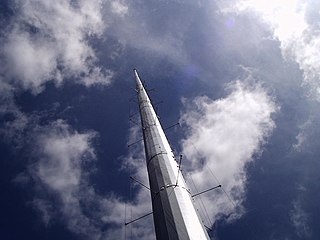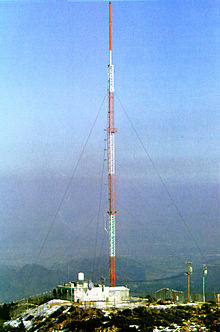
Medium wave (MW) is the part of the medium frequency (MF) radio band used mainly for AM radio broadcasting. The spectrum provides about 120 channels with more limited sound quality than FM stations on the FM broadcast band. During the daytime, reception is usually limited to more local stations, though this is dependent on the signal conditions and quality of radio receiver used. Improved signal propagation at night allows the reception of much longer distance signals. That can cause increased interference because on most channels multiple transmitters operate simultaneously worldwide. In addition, amplitude modulation (AM) is often more prone to interference by various electronic devices, especially power supplies and computers. Strong transmitters cover larger areas than on the FM broadcast band but require more energy and longer antennas. Digital modes are possible but have not reached momentum yet.

The Gerbrandy Tower is a tower in IJsselstein, the Netherlands. It is also known as Lopik tower after the nearby town. It was built in 1961.

A guy-wire, guy-line, guy-rope, down guy, or stay, also called simply a guy, is a tensioned cable designed to add stability to a freestanding structure. They are used commonly for ship masts, radio masts, wind turbines, utility poles, and tents. A thin vertical mast supported by guy wires is called a guyed mast. Structures that support antennas are frequently of a lattice construction and are called "towers". One end of the guy is attached to the structure, and the other is anchored to the ground at some distance from the mast or tower base. The tension in the diagonal guy-wire, combined with the compression and buckling strength of the structure, allows the structure to withstand lateral loads such as wind or the weight of cantilevered structures. They are installed radially, usually at equal angles about the structure, in trios and quads. As the tower leans a bit due to the wind force, the increased guy tension is resolved into a compression force in the tower or mast and a lateral force that resists the wind load. For example, antenna masts are often held up by three guy-wires at 120° angles. Structures with predictable lateral loads, such as electrical utility poles, may require only a single guy-wire to offset the lateral pull of the electrical wires, at a spot where the wires change direction.

The Mühlacker Broadcasting Transmission Facility is a radio transmission facility near Mühlacker, Germany, first put into service on November 21, 1930. It uses two guyed steel tube masts as aerials and one guyed steel framework mast, which are insulated against ground. It has two transmission aerials for shortwave and one free standing steel framework tower for directional radio services. The shortwave transmitter was shut off on October 19, 2004. The medium wave transmitter was switched off in January 2012.

The Eifel Transmitter is an FM and TV transmission facility for the German broadcasting company of SWR and is located on the Scharteberg near Kirchweiler, Germany. Until 1985, the Scharteberg transmitter used a 160 metre tall guyed mast. However this mast did not allow good reception in deep valleys, so in 1985 a new, 302 metre tall, guyed, steel framework mast was built, becoming the tallest structure of Rhineland-Palatinate. The elements of this mast were built by the firm of Hein, Lehmann AG, whilst construction work was carried out by BBS AG, Ludwigshafen. The first 20 metres of the mast were built using a small crane. The mast elements in heights between 20 and 100 metres were mounted by the aid of a car crane, while for the sections above a derrick crane was used. The new mast of Scharteberg transmitter consists of a 288 metre tall, guyed, lattice, steel structure with a square cross section, a side length of 2.1 metres and a 14 metre long GFK-cylinder on top for the UHF antenna. The total weight of the structure is 204 tons. The mast is guyed at 4 levels, 57, 123, 195 and 273 metres above ground. It is equipped with an elevator which runs up to a height of 281 metres. For aircraft warning 20 red neon lamps and two blinking lights with 1000 watt lamps are installed.

The Rheinsender is an FM radio transmission site for the German Südwestrundfunk regional public broadcasting system. The Rheinsender is located near Wolfsheim, southwest of Mainz.
The Monte Ceneri transmitter was first established as the nationwide medium-wave radio transmission station for Italian-speaking Switzerland in 1933. Located on Monte Ceneri in Ticino, it broadcast on a frequency of 558 kHz.

The Blaw-Knox company was an American manufacturer of steel structures and construction equipment based in Pittsburgh, Pennsylvania. The company is today best known for its radio towers, most of which were constructed during the 1930s in the United States. Although Blaw-Knox built many kinds of towers, the term Blaw-Knox tower usually refers to the company's unusual "diamond cantilever" design, which is stabilized by guy wires attached only at the vertical center of the mast, where its cross-section is widest. During the 1930s AM radio broadcasting stations adopted single mast radiator antennas, and the Blaw-Knox design was the first type used. A 1942 advertisement claims that 70% of all radio towers in the United States at the time were built by Blaw-Knox.

The Żórawina radio transmitter is a facility for FM transmission at Żórawina, south of Wrocław. It was established in 1932 as "Reichssender Breslau" and used as an antenna tower. Originally it was a 140-metre-tall free-standing lattice tower built of wood, on which a wire antenna was hung up. On the top of the tower there was an octagonal ring of bronze with a diameter of 10.6 metres for electrical lengthening of the antenna.

Radio masts and towers are typically tall structures designed to support antennas for telecommunications and broadcasting, including television. There are two main types: guyed and self-supporting structures. They are among the tallest human-made structures. Masts are often named after the broadcasting organizations that originally built them or currently use them.

A mast radiator is a radio mast or tower in which the metal structure itself is energized and functions as an antenna. This design, first used widely in the 1930s, is commonly used for transmitting antennas operating at low frequencies, in the LF and MF bands, in particular those used for AM radio broadcasting stations. The conductive steel mast is electrically connected to the transmitter. Its base is usually mounted on a nonconductive support to insulate it from the ground. A mast radiator is a form of monopole antenna.
New Zealand Masts and Towers range in size from short flagpoles to high radio transmitter antenna structures. The highest mast is in Titahi Bay, being the highest structure in the Southern Hemisphere at time of construction. Later it became the highest in New Zealand and then later second to the Sky Tower in Auckland.

The folded unipole antenna is a type of monopole mast radiator antenna used as a transmitting antenna mainly in the medium wave band for AM radio broadcasting stations. It consists of a vertical metal rod or mast mounted over and connected at its base to a grounding system consisting of buried wires. The mast is surrounded by a "skirt" of vertical wires electrically attached at or near the top of the mast. The skirt wires are connected by a metal ring near the mast base, and the feedline feeding power from the transmitter is connected between the ring and the ground.

An umbrella antenna is a capacitively top-loaded wire monopole antenna, consisting in most cases of a mast fed at the ground end, to which a number of radial wires are connected at the top, sloping downwards. One side of the feedline supplying power from the transmitter is connected to the mast, and the other side to a ground (Earthing) system of radial wires buried in the earth under the antenna. They are used as transmitting antennas below 1 MHz, in the MF, LF and particularly the VLF bands, at frequencies sufficiently low that it is impractical or infeasible to build a full size quarter-wave monopole antenna. The outer end of each radial wire, sloping down from the top of the antenna, is connected by an insulator to a supporting rope or cable anchored to the ground; the radial wires can also support the mast as guy wires. The radial wires make the antenna look like the wire frame of a giant umbrella hence the name.

The Wiederau transmitter is the oldest broadcasting facility in Saxony. It is located near Wiederau, a village which is part of the municipality of Pegau, and is used for medium-wave, FM and Television broadcasting.

Ravensburg-Horgenzell transmitter was a mediumwave broadcasting facility of Deutsche Telekom used for transmitting the program of Deutschlandfunk on the area of community Horgenzell northwest of Ravensburg in Baden-Württemberg. It was inaugurated on August 23, 1951, and used until 1959 for transmitting the radio programme of SWF with a transmission power of 40 kW on 1538 kHz. As antenna, it used a 120 metre tall guyed ground-fed lattice steel mast radiator at 47°47'10" N and 9°31'16" E.
Hoher Meissner transmitter is a facility for FM and TV broadcasting on Hoher Meissner mountain in Northern Hesse. The transmitter was inaugurated in 1952.
The NHK Kawaguchi Transmitter was a medium-wave broadcasting station at Kawaguchi, Saitama, Japan, which was built in 1937. It used for transmissions on 590 kHz with a power of 150 kW, a T-antenna, which was spun between two 312.78-metre-tall guyed masts, which were 463 m apart and which were both insulated against ground.
Col de la Madone transmitter is a very large broadcasting centre operated by Radio Monte Carlo north of Fontbonne, near Nice and Monaco, in France. It was established in 1965 and was used until completion of Roumoules radio transmitter for longwave broadcasting, using 3 320 metres tall guyed mast radiators, which do not exist any more. It was used for broadcasting on 702 kHz and 1467 kHz. Both antennas consist of 2 guyed mast radiators insulated against ground. The masts of the antenna for 1467 kHz are 101 metres tall and oriented in North-South direction. The masts of the antenna for 702 kHz are oriented in East-West direction pointing towards Milan, as it is used for transmitting a radio program in Italian language toward Italy. The western mast of this antenna, which acts as reflector, has a height of 250 metres while the eastern mast which is the radiator is 215 metres taller. Not far to the south, there is a centre for FM-broadcasting close to a military radar site and on Mount Angel there is a 146 metres tall partially guyed tower, which consists of a grounded lattice tower as basement and a guyed mast radiator insulated against ground as top. It was built in 1946 and first used for mediumwave broadcasting, but is today used for TV-broadcasting. Nearby there is also the shortwave transmitter of RMC with several dipole walls.

The Emley Moor transmitting station is a telecommunications and broadcasting facility on Emley Moor, 1 mile (1.6 km) west of the village centre of Emley, in Huddersfield, West Yorkshire, England.






















